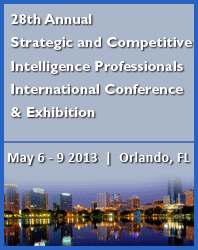 |
||||
|
||||
|
CONFERENCE HIGHLIGHT Getting the Most Intelligence From SCIP13
In three days at a trade show you can accomplish more than you could in a full year using other means, but only if “properly organized.” In this article I’ll show you how you can maximize the value of the 28th Annual Strategic and Competitive Intelligence Professionals International Conference & Exhibition — using what I will refer to as a SCIP toolkit — within a proper event intelligence organization framework. The conference is one of the best event intelligence opportunities for anyone interested in competitive intelligence with:
STEP 1: IDENTIFY THE CONFERENCE’S “RAW MATERIALS” FOR THE KIT I look through all the conference materials for anything that points me in the direction of my KIT and information needs. What sessions appear to be on topic for my KIT? An example at this year’s conference is Tuesday’s session at 4:30, “Predicting market dynamics and growth.” The presenter (Victor Acquaviva) will be talking about a methodology he developed for a highly competitive consumer market company in Brazil. Not only is the topic specifically related to my KIT, but I suspect that others who attend the session will also share my interests. Are there any sessions that, while not exactly on topic for my KIT, have speakers who could have information related to my KIT? I go through the list of speakers and topics for both subject matter expertise and country expertise. What booths appear to have information that I need for my KIT? One that strikes me almost immediately is Global Intelligence Alliance (GIA). GIA is one of the largest intelligence consulting firms with an active practice in Latin America. Their President, Hans Hedin is a very approachable and well-connected person who by reputation I am sure would introduce me to his Latin American staff. But he is a busy man and I can’t count on simply bumping into him, I should reach out before the event. STEP 2: IDENTIFY OTHERS AT THE EVENT WHO MAY HAVE THE NEEDED SUBJECT MATTER EXPERTISE A variation of the second stop above, this is about identifying additional people who may have information pertinent to my KIT. This is where my SCIP toolkit comes in handy — this kit is only available to members so if you have not joined, perhaps this will give you a reason to.
My list of potential people to talk to is far longer than simply the speakers at the event and I am hoping that those individuals will be among the other attendees at the event. Once again I have several options at my disposal. I can get to the SCIP event as early as possible to register and to pick up the attendee list. SCIP provides this for all who registered and I can use this to identify what “badges” to look for. Or I can email the names I have pulled up (using the SCIP toolkits members directory), introduce myself as a fellow SCIP member and mention what I need to learn from them. STEP 3: PUT PLAN AND SCHEDULE TOGETHER I now need to consider my schedule at the event as well as my resource plan. I have a list of names of people to see, booths to visit, and workshops/sessions to attend that match my intelligence needs. As I overlay the names, booths, and sessions, I note that I do have conflicts. Virtually every day multiple sessions that I need to cover are scheduled at the same time. I am sure that once I get the schedule for the lunchtime networking I will have additional conflicts. Teaming at events can be a lot of fun. Basically it amounts to me offering to collect information at a session for someone if they will collect for me at another session. Good thing I know several people going to the event and can team up in this way. But if you are truly on your own, take the time to read chapters from Conference and Trade Show Intelligence edited by myself and Bonnie Hohhof. Several chapters talk about how to do a good CI job at an event even when you are on your own. STEP 4: BUILD INTO YOUR SCHEDULE TIME FOR ASSESSMENT, COMMUNICATIONS, AND MORE PLANNING AND MANAGEMENT You have three days at SCIP, but gathering intelligence is not only about collecting, it’s also analysis, communication, management, and planning — the wheel of intelligence. At some point each day give yourself time to look at what you have gathered and assess it. This step is particularly critical since now with the social networking side of events (SCIP13 Twitter feed for example) I also need to take the time to assess what has been Tweeted and put out some of my own questions into the Twittersphere or elsewhere in the social network. It’s called the wheel of intelligence and by definition it includes planning, collection, analysis, communications and management — all can and need to be done at the event. STEP 5: PREPARE PLANS TO GATHER INFORMATION The Conference and Trade Show Intelligence book covers how to effectively interview at trade shows and conferences, it’s an art. But it starts with knowing what you want and from who (steps 1 and 2) and then goes to developing a good understanding of the people you will be interviewing. For each person I am going to interview I develop a detailed profile. Once again I turn to SCIP — I read any article they have written. Social media is also a great tool to learn about a person and again SCIP has a lot of material on that. I am acquiring this background information for two reasons:
Do not assume that you can talk to 10+ people in a day, attend a bunch of sessions and then summarize all that information at night. Think about how you will make notes as the day goes on, what you will carry on you to make this happen and so forth. One SCIP member told me how during a conference they run to the bathroom after each interview, sit in the stall and make notes. My parting advice is to get your KIT’s and information needs ready for SCIP13. Talk to your internal or external clients and determine how to best use the event. If your objective is to improve your intelligence program itself, be sure to look for the people and sessions that deal with those elements that need improvement. Be “intelligent” at SCIP13. About the Author Jonathan Calof is the professor of International Business and Strategy at the Telfer School of Management at University of Ottawa. He combines research and consulting in competitive intelligence, technical foresight and management insight in the creation of the Universities management insight program. Jonathan is a Board member for CASIS, is a co-director of the Foresight Synergy Network, and received the Fellow award from SCIP. He has close to 200 publications to his credit including co-editing the Competitive Intelligence Foundations Conference and Trade Show Intelligence book. He can be reached at 01.613.228.0509 or calof@telfer.uottawa.ca. |
|
|||||||||||||||||||||||||||||||||||||||||||||||||||||||||||||||||||||||||||||||||||||||||||||||||||||||||||||||||||||||||||||||||||||||||||||||||||||||||||||||||||||||||||||||||||||








